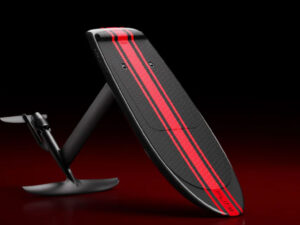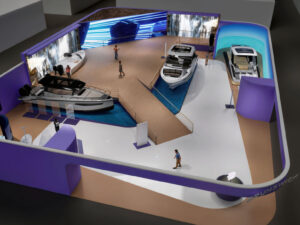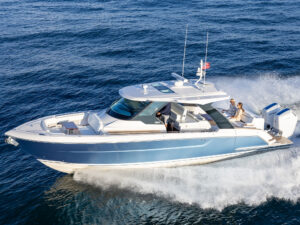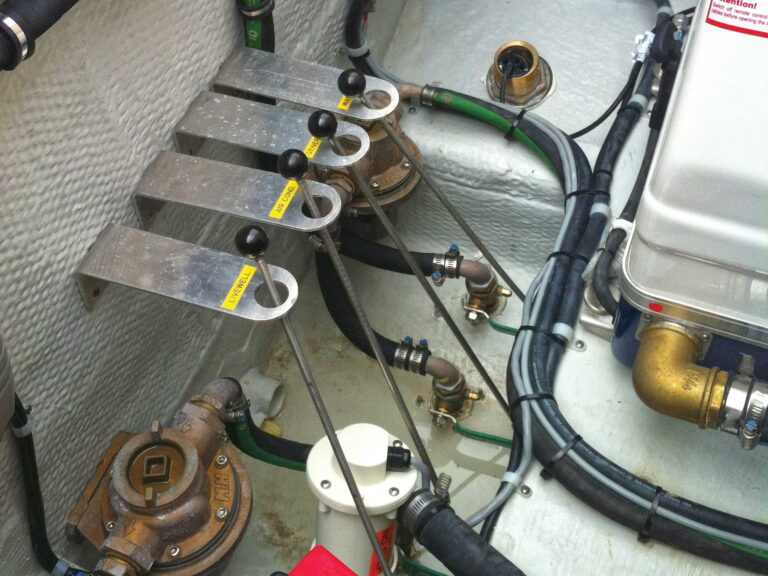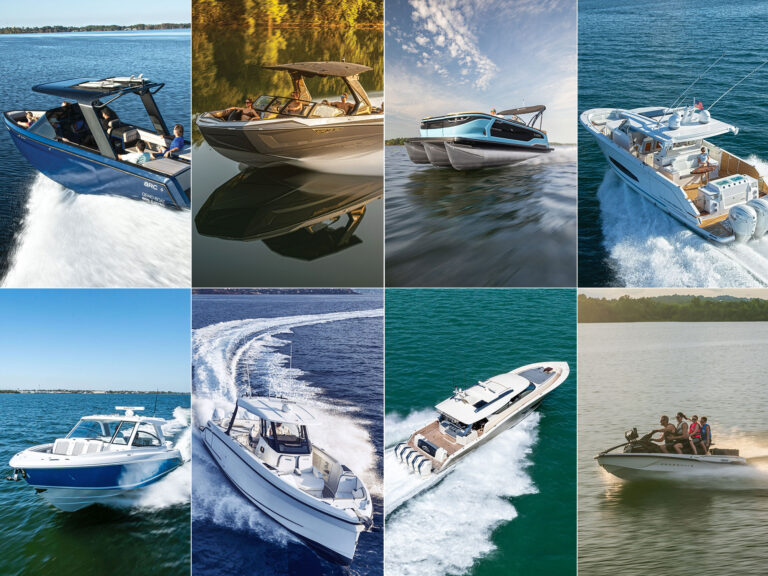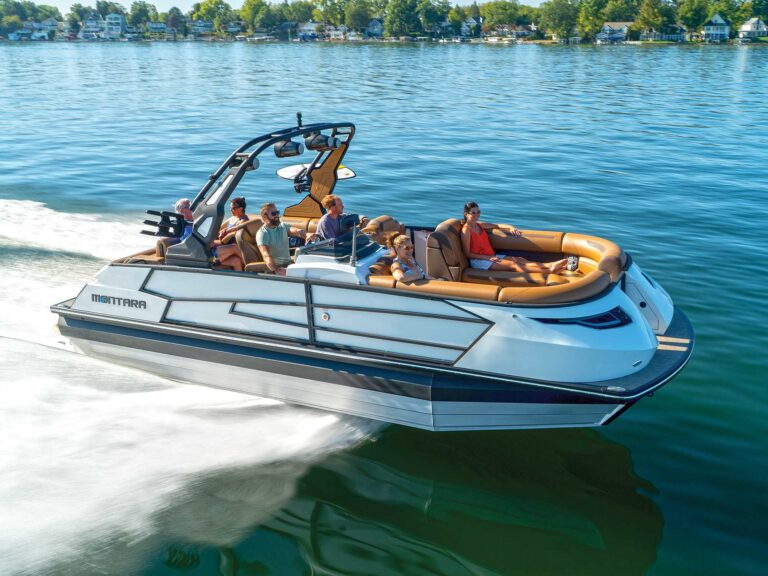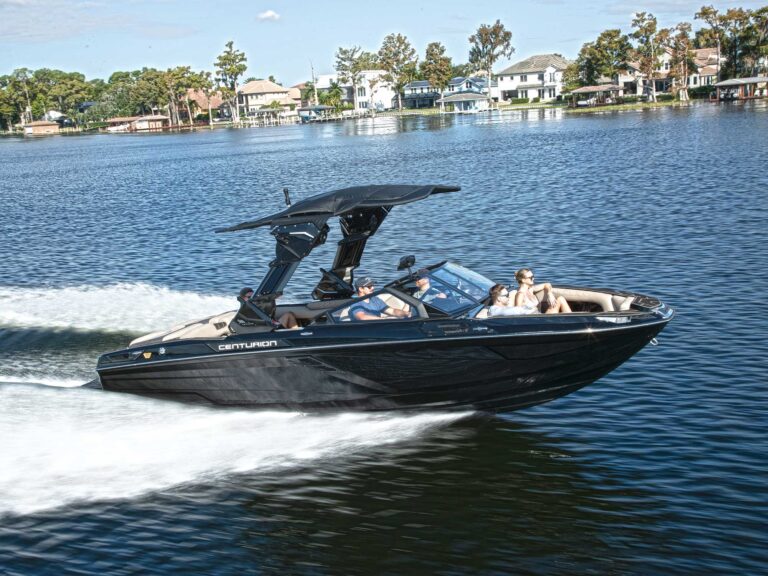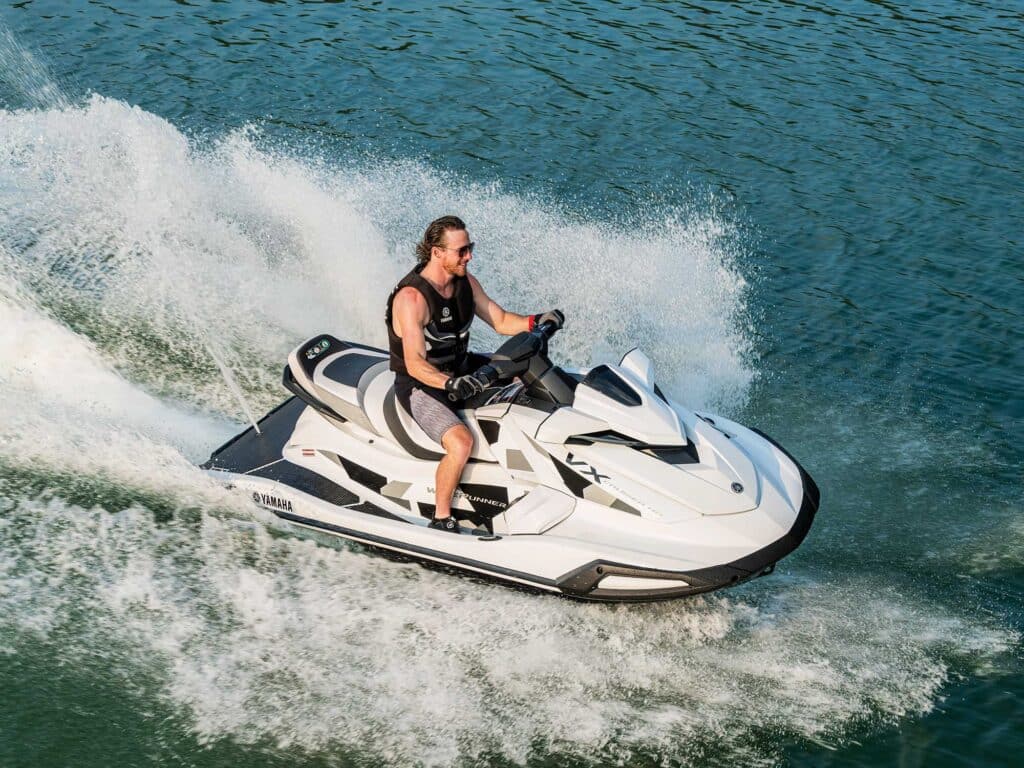
Originally conceived as a “motorcycle or snowmobile for the water,” today’s personal watercraft have matured far beyond simple thrill rides to reflect the diverse interests of the modern buyer.
Yes, performance on the high-end is more of a thrill than ever. Sea-Doo, Yamaha and Kawasaki (the owner of the commonly used term Jet Ski) all produce models that boast impressive acceleration, run in the 65 mph range and corner with ferocity. Those same manufacturers, however, also produce recreational models aimed at first-time buyers, midrange models that combine thrills with fuel efficiency, and specialty craft that target everyone from the fishing to watersports crowd.
Boating Magazine editors have performed on-water testing of nearly every model over the last two decades. Our insight and expert tips can help you narrow a sea of choices to find the ideal craft for you and your family. Here are some of our favorites, but keep in mind the market is quite large and numerous models may prove an ideal choice for individual buyers.
Article at a glance:
PWC Recommendations by Type
Just like the broader boating market, some personal watercraft are better suited to certain activities than others. Popular categories include recreational and touring craft, high-performance models and fish-and-family fun models.
Review the best jet skis by type:
Best Jet Skis for Fishing
Virtually any PWC can be used for casual fishing, but several recent models have taken aim at the more hardcore angler with amenities including rodholders, coolers, and GPS/Fishfinders. Sea-Doo’s Fish Pro series tops the list. Yamaha, meanwhile, offers several fishing-specific accessory packages. Find a more extensive list of the best PWC for fishing in our recent article.
Sea-Doo Fish Pro Trophy
The ultimate fishing-ready PWC, with amenities to satisfy the most serious angler.
Sea-Doo is currently the only manufacturer producing a dedicated fishing line, and the Fish Pro Trophy is the flagship of the trio. Based on the GTX hull platform, the Trophy is exceptionally stable, both underway and at rest. The latter trait makes it possible to stand and cast or battle even the most spirited catch without worries of going overboard. Fishing amenities include a 13.5-gallon cooler plumbed to double as a livewell, 7” Garmin touchscreen GPS/Fishfinder, raw-water washdown and an innovative saddle design that allows the rear portion of the seat to convert into a raised, pedestal fishing chair. Additional features include a debris-flushing pump system ideal for skinny, weed-prone waters, low-speed trolling modes added to the craft’s speed control, heavy-duty batteries with 650-watt voltage generator and quick-release anchor. Power is provided by a naturally aspirated, 170hp Rotax engine that proves quite powerful yet fuel-efficient for increased range.
Pricing and Specs
| Starting MSRP: | $20,499 |
| Dimensions: | Length 146.8”; Width 49.4”; Weight 938 lbs. |
| Engine: | 170hp Rotax 1630 ACE |
| Seat/Weight Capacity: | 3/600 lb. |
| Fuel/Storage Capacities: | 18.5 gal./39.6 gal. |
| Key Features: | Garmin 7” touchscreen GPS/Fishfinder, rodholders, 13.5-gallon cooler/livewell, pedestal fishing seat, washdown, anchor, weed-free pump system |
What we like:
- Long list of standard features, ready to satisfy the most hardcore angler.
- Excellent stability, particularly at rest.
- Naturally aspirated engine improves fuel efficiency, extends range.
What could be better:
- Significant weight aft, particularly with a loaded cooler, can affect handling.
Yamaha FX HO w/RecDeck
Choice of optional fishing packages increase versatility of standout performer.
Rather than a dedicated fishing model, Yamaha builds upon a foundation of the flagship FX-series hull and 1.9-liter, naturally aspirated engine. Together, it’s a package ready for anything from calm lakes to rough, offshore conditions and offers exceptional stability underway or at rest. Buyers can choose how “fishy” to make their FX. We suggest starting with the RecDeck, a broad platform that mounts atop the existing swim platform to greatly increase deck space aft and serve as the mounting point for one of two optional fishing packages. The Premium JetFish package adds a multi-use rack atop the platform that secures a cooler and includes a pair of both rod and cup holders. Additional eyelets and tiedowns secure other gear. A choice of Garmin GPS/Fishfinders can also be added to the console, including a 6” EchoMap.
Pricing and Specs
| Starting MSRP: | $15,699 |
| Dimensions: | Length 140.9”; Width 50”; Weight 827 lbs. |
| Engine: | 1898cc Yamaha High Output |
| Seat/Weight Capacity: | 3/NA |
| Fuel/Storage Capacities: | 18.5 gal./44.5 gal. |
| Key Fishing Features: | Options include RecDeck platform; JetFish Packages (cooler, rodholders); choice of Garmin GPS Fishfinders |
What we like:
- RecDeck includes pull-out boarding ladder, options beyond fishing, including rear-facing lounge seat.
- FX hull tracks straight and true in rough water.
- Naturally aspirated engine improves fuel efficiency, extends range.
What could be better:
- Cooler only; livewell option would add versatility.
- RecDeck and accessories add considerable weight aft, affecting handling.
– ALWAYS USE YOUR ENGINE CUT-OFF LANYARD –
Safety Tip Provided by the U.S. Coast Guard
Make sure your Engine Cut-Off Switch lanyard is attached to your person. They’re required on all personal watercraft and boats under 26 feet.
Best Recreational & Touring Personal Watercraft
One of the most versatile segments of the PWC market, recreational and touring models typically offer stable, three-passenger hull designs and forego gas-hungry supercharged engines in favor of naturally aspirated alternatives that increase range and stretch a fuel budget. Plenty of power is still on hand to satisfy the performance-minded solo rider or pull watersports lovers on tube or board, but comfort is equally important. Expect cushy, supportive saddles and modern electronic enhancements like cruise control and available sound systems.
Kawasaki Ultra 160LX-S
Midrange model combines latest flagship amenities with touring-friendly, fuel-efficient engine.
Kawasaki plays the morphing game with the Ultra 160LX-S, combining the flagship style and high-tech features offered on the flagship Ultra 310 LX with a more touring-friendly, non-supercharged version of its 1,498cc engine that promises to run far longer between fuel stops. Highlights include a tiered saddle to keep both driver and passengers comfortable on extended cruises, an intuitive electronic reverse and deceleration system, 7” color information display and 200-watt, four-speaker sound system. Unique? A rearview camera that comes in handy not only when backing up in tight confines, but also monitoring overtaking traffic when running in open water.
Pricing and Specs
| Starting MSRP: | $17,199 |
| Dimensions: | Length 140.9”; Width 47”; Weight 964 lbs. |
| Engine: | 1498cc Kawasaki |
| Seat/Weight Capacity: | 3/NA |
| Fuel/Storage Capacities: | 21.1 gal./44.5 gal. |
| Key Fishing Features: | Aft platform track mounting system |
What we like:
- Proven hull design offers a stable, predictable ride in all water conditions.
- Cruise control, no-wake mode, auto-trim, stylish LED accent lights.
- Aft platform track system can secure cooler, gas caddy or other accessories.
What could be better:
- Slight lag when transitioning between forward, neutral and reverse.
- Gullwing storage solution is unique and keeps items close at hand, but can be slightly awkward to reach around handlebars.
Sea-Doo GTX
Comfortable, cushy cruiser offers power, handling…and innovative storage and cargo options.
The GTX hits the recreational/touring sweet spot with its combination of the flagship GTX hull design and more fuel-efficient, touring-friendly version of the Rotax 1630 ACE engine rated at 170hp. Touring riders will love the tiered, three-passenger saddle with its pronounced bolsters offering lower-back support. Cruise control and no-wake modes lock in speeds to alleviate throttle fatigue. An extended aft deck, equipped with pop-up LinQ accessory mounts, is ready for extra gear including cooler, storage bag or fuel caddies.
Pricing and Specs
| Starting MSRP: | $15,199 |
| Dimensions: | Length 135.9”; Width 49.4”; Weight 776 lbs. |
| Engine: | Rotax 1630 ACE – 170 |
| Seat/Weight Capacity: | 3/600 lb. |
| Fuel/Storage Capacities: | 18.5 gal./26.1 gal. |
| Key Fishing Features: | Debris-Free pump System; Electronic Brake/Reverse; Variable Trim; LinQ attachment system; direct-access front storage; optional audio system |
What we like:
- Innovative bow storage opens directly in front of the driver, offering access to the contents without leaving the saddle or stretching over the handlebars.
- Intelligent Debris Free pump system spins driveshaft in reverse to flush away debris and weeds.
- Electronic reverse and braking system provides intuitive low-speed handling, powerful deceleration at speed.
What could be better:
- LinQ accessories integrate seamlessly, but can be somewhat pricey add-ons.
- Front storage more convenient, but smaller than competitive models.
Yamaha VX Cruiser HO
One of the best-selling platforms in market history, with cruiser-specific saddle and the largest displacement engine on the market.
Yamaha’s VX has dominated sales charts for over a decade thanks to a stable yet agile hull design, reliable engine and affordable price tag. The current model gets a boost in horsepower from a new 1.9-liter engine, the largest displacement seen yet in the PWC market. It gives the VX Cruiser HO impressive power without the fuel-hungry needs of a supercharger. Elsewhere, find a 4.3” color display with touchpad controls, user-selected top speed and acceleration settings, and Yamaha’s dual-throttle RiDE system which provides intuitive low-speed control of forward/neutral/reverse motion and rapid deceleration at speed. A Cruiser saddle positions each rider higher than the one in front, and offers generous back support.
Pricing and Specs
| Starting MSRP: | $13,599 |
| Dimensions: | Length 132.7”; Width 48.8”; Weight 780 lbs. |
| Engine: | 1898cc Yamaha High Output |
| Seat/Weight Capacity: | 3/NA |
| Fuel/Storage Capacities: | 18.5 gal./30.1 gal. |
| Key Fishing Features: | Aft platform track mounting system |
What we like:
- Connext LCD display includes Ride Control speed/acceleration profiles, security mode.
- Cruise control, no-wake mode, intuitive RiDE dual throttle system, optional Bluetooth audio system.
- Watertight glovebox w/USB/12-volt charging port, LED lighting.
What could be better:
- Connext display provides access to impressive amount of information/control, but not always the most intuitive to navigate.
– RIDE DEFENSIVELY –
Safety Tip Provided by the U.S. Coast Guard
Personal watercraft are the motorcycles of the sea. Never assume other boaters can see you, so avoid high-traffic areas when you can and always ride defensively.
Best Jet Skis for High-Performance
The “Top Guns” of the PWC world, these craft offer supercharged engines that accelerate at lightning speed, easily hit the 65 mph mark and, thanks to deep-V hull designs and aggressive sponsons, handle with slot-car-like precision. Look for ergonomic touches that keep a rider planted and in control, like sculpted, bolstered seats, adjustable handlebars and plenty of footwell traction. Extras can include automatic trim systems, selectable power curves and optional Bluetooth sound systems to cue up your favorite soundtrack.
Yamaha GP SVHO
A race-proven craft that excels in a variety of water conditions, and offers some of the most aggressive handling on the market.
GP models have earned a reputation amongst PWC performance enthusiasts for decades, and the current GP SVHO continues to live up to the hype. Powered by Yamaha’s 1.8-liter Super Vortex High Output engine, it provides the GP with more power and torque than any WaveRunner in the brand’s history. Drop that engine into a hull with both lightning-fast reflexes and rough-water credentials, and you’ve got a pro-ready race machine right out of the box. While performance reigns supreme, the GP is not without bells and whistles. Yamaha’s dual-throttle RiDE system offers intuitive forward/neutral/reverse low-speed maneuvering in tight confines, as well as rapid deceleration when desired at speed. A 4.3” color touchscreen display keeps tabs on vitals, as well as allows adjustment of top speed and acceleration profiles.
Pricing and Specs
| Starting MSRP: | $16,799 |
| Dimensions: | Length 131.9”; Width 48.8”; Weight 754 lbs. |
| Engine: | 1812cc Yamaha Super Vortex High Output w/supercharger |
| Seat/Weight Capacity: | 3/NA |
| Fuel/Storage Capacities: | 18.5 gal./28.4 gal. |
| Key Fishing Features: | RiDE reverse/deceleration system; touchscreen info display; speed/acceleration profile control; cruise control/no-wake mode; optional Bluetooth audio system |
What we like:
- Cruise Assist/No-Wake modes are welcome extras for longer-distance rides.
- Deep, wide footwells and sculpted saddle put riders in aggressive, yet comfortable position. Adjustable handlebar tilt further dials in fit.
- Optional 100-watt Bluetooth sound system integrates two 4.5” speakers into the design, operated by convenient touchpad.
What could be better:
- Not a negative as much as a reminder. Skis like the GP are targeted at skilled, experienced riders and not meant for beginner/intermediate riders.
- Though improved, ergonomics and turning style still put a lot of force on a rider’s upper body. Hit the gym.
Sea-Doo RXP-X 325
The newest horsepower king, offering an industry-topping 325 horsepower and multiple ergonomic touches.
Sea-Doo’s RXP-X 325 has long been defined by its incredibly tight-turning hull and ergonomic tweaks that allow riders to transfer much of the strain of those turns from the upper body to the stronger legs and trunk. But for 2025, it’s probably best known by its new 325hp Rotax engine that produces the highest horsepower ever seen in the PWC market. You can definitely feel it. Pin the throttle, hold on tight and the 60 mph threshold passes by in as little as 3.4 seconds. The increased power only adds to the RXP-X’s turning ability. An adjustable backrest adds to the craft’s ErgoLock features to keep the pilot in control. Riders can now also dial in the feel of the handlebars via an adjustable steering damper that eliminates play and stiffens response to reduce unwanted feedback, especially in rough conditions.
Pricing and Specs
| Starting MSRP: | $19,199 |
| Dimensions: | Length 130.6”; Width 49.2”; Weight 778 lbs. |
| Engine: | Rotax 1630 ACE – 325 w/supercharger |
| Seat/Weight Capacity: | 2/400 lb. |
| Fuel/Storage Capacities: | 18.5 gal./40.6 gal. |
| Key Fishing Features: | Aft platform track mounting system |
What we like:
- Intelligent Brake & Reverse provides rapid deceleration at speed, but also shines at low-speed with intuitive control of forward, neutral and reverse.
- Launch Control automates trim position during acceleration, providing the optimal running angle for best performance.
- Optional Tech Package adds full-color 7.8” display, 100-watt Bluetooth audio system, smartphone app integration for music, weather and navigation.
What could be better:
- Not a negative as much as a reminder. Skis like the RXP-X are targeted at skilled, experienced riders and not meant for beginner/intermediate riders.
- App integration not always intuitive, can be glitchy.
Kawasaki Ultra 310X
Longtime offshore racing champ combines brutal power delivery with one of the most confident rides in rough water.
Kawasaki’s Ultra 310 line has built a reputation on impressive offshore racing performance, racking up countless racing titles over the years. But despite being the largest, heaviest craft in this lineup, the Ultra 310X is also no slouch in calm conditions, carving up the water with the precision and feel of a much smaller craft. The 310X makes full use of its 310 horsepower and Eaton twin-vortices supercharger, powering out of the hole and easily reaching 68+ mph. For such a beastly performance machine, the Ultra is also quite practical. Storage tops 40 gallons, with the large bow tub complemented by additional gullwing storage compartments to each side of the console for easy access from the driver’s seat. Other highlights include a vivid 7” color display with analog control knob and the long-awaited adoption of electronic reverse and deceleration, integrated into the craft’s righthand throttle.
Pricing and Specs
| Starting MSRP: | $19,199 |
| Dimensions: | Length 135.4”; Width 47”; Weight 1,032 lbs. (curb weight) |
| Engine: | Kawasaki 1,498cc w/supercharger |
| Seat/Weight Capacity: | 2/400 lb. |
| Fuel/Storage Capacities: | 18.5 gal./40.6 gal. |
| Key Fishing Features: | Adjustable drive-control modes; electronic trim, cruise control/no-wake modes; governed-speed learning key |
What we like:
- Deep-V hull is excellent in both rough inland waters and offshore conditions, tracking straight and true.
- Deeply bolstered saddle locks driver in during performance runs, provides tiered seating for passengers when cruising.
- Watertight phone compartment integrated into starboard side storage.
What could be better:
- Innovative side storage theoretically keeps items close at hand, but some may slide forward out of reach.
- Not a negative as much as a reminder. Skis like the Ultra 310X are targeted at skilled, experienced riders and not meant for beginner/intermediate riders.
– ALWAYS WEAR YOUR LIFE JACKET –
Safety Tip Provided by the U.S. Coast Guard
Get a comfortable U.S. Coast Guard-approved life jacket designed for use on a PWC, and make sure you wear it every time. It’s the law, even for adults.
Things to Consider When Buying a Jet Ski
Need more helping narrowing down your options? Here are five important issues to consider before buying your next PWC.
- How – and where – craft will be used: Take into consideration not only how you plan to use your craft and who with, but also the typical water conditions you’ll encounter.
- Important features: Touring riders will benefit from comfort and cargo options, performance riders trim systems, anglers rodholders and coolers.
- Storage: How you plan to use your craft will also dictate storage needs, but also consider ease of access, both on land and on water.
- Safety: Modern craft are all quite safe, but don’t get in over your head. High-performance models require skilled riders that can handle the horsepower and handling.
- Price: Like any other purchase, budget wisely. While flagship craft can run as high as $20,000, a $7,000 entry-level model can still offer plenty of fun.
New PWC Kit
Buying a new personal watercraft? Here are some items you want to buy to help make your rides safer and more enjoyable. This list curated by the editors of Boating, who possess more than 200 years of combined boating experience.
PWC Lifejacket: These fulfill the US Coast Guard requirements for those who ride PWCs to help keep you safe. Check them out!
Shorty Wet Suit: These shorty wetsuits will keep you comfy and safe from injury while riding.
Whistles or Portable Horn: These Coast Guard required sound-making devices help you alert and warn other riders and boaters.
Safety Flag: Orange safety flags help you visually signal other riders and boater for help in an emergency.
- Caddie Buddy Safety Flag (2 pack in case you buy two PWCs)
- Sirius Signal Distress Flag
- Shoreline Marine Distress Signal Flag
Handheld VHF Radio: A compact, waterproof handheld VHF lets you call the Coast Guard, other rescue agencies and other riders and boater for assistance.
Electronic Flare: These electronic signaling devices let you signal in a distress situation after dark, and when combined with a daytime signal flag meet Coast Guard requirements for vessel signaling devices.
The stream from a PWC waterjet can hurt if it strikes the rider or passenger’s groin area. Protect against this happening by wearing a shortie wetsuit, neoprene dive shorts, pants or leggings. Here are some examples:
Other FAQs about PWCs
Have more questions about personal watercraft? Check out our list of frequently asked questions below, as well as extensive reviews of many models in the pages of Boating Magazine and at boatingmag.com.
- What are the most important features to consider for a jet ski?
Safety, comfort and ease of use are important on any model, as well as the intuitiveness of controls like electronic reverse and deceleration systems. Beyond that, consider how you plan to use the craft and look for additional features — performance enhancements, fishing amenities, storage availability — tailored to your interests.
- How much do jet skis cost on average?
The lowest-priced PWC currently on the market is the Sea-Doo Spark at $6,999. The most expensive? Kawasaki’s flagship Ultra 310LX at $21,199. Midrange models typically hit the sweet spot, offering many of a flagship’s features without the cost of a supercharged engine.
- Do you need a boating license to drive personal watercraft?
Laws vary by state, so always check local regulations. The minimum age to operate a PWC is typically 12 – 18 years of age. Most states also require riders of a certain age to take a boating safety course and possess a valid certificate of completion.
- How to find laws for personal watercraft in your state?
The best resource for individual state laws and requirements has been compiled by the National Association of State Boating Law Adminstrators (NASBLA) and can be found at www.nasbla.org/nasblamain/nasbla-resources/statelawdashboards
- What are the best jet skis to consider for beginners?
Craft like Sea-Doo’s Spark and GTI, Yamaha’s EX and VX and Kawasaki’s STX 160 offer a great starting point for beginning riders, with stable hulls, enough horsepower to be fun but not overwhelm, and price tags that will leave enough money leftover for plenty of gas throughout the season.
- How long do jet skis normally last?
According to JD Power, personal watercraft engines have an average lifespan of 300 hours. Though that may not sound that long, consider that average yearly use is only 30 hours. As always, a PWC’s lifespan is impacted greatly by how well a craft is maintained.
- Can all jet skis be used in fresh and saltwater?
Yes, all personal watercraft can be used in both fresh and saltwater. Saltwater use, however, requires more care. Engines should be flushed with fresh water after use, easily done through provided flush fittings, to prevent deposits and eventual corrosion. Craft should also be rinsed on the exterior and added attention paid to the jet pump.
- Can jet skis pull skiers, tubes and board riders?
Three-passenger PWC can all pull watersports riders and often make an excellent, less-intimidating tow platform for teaching children. Without the confines of a boat, the spotter is easily seen and can offer assurance. Craft are also agile enough to quickly return to downed riders. Always use a spotter, and consider cruise control to keep speeds steady.


